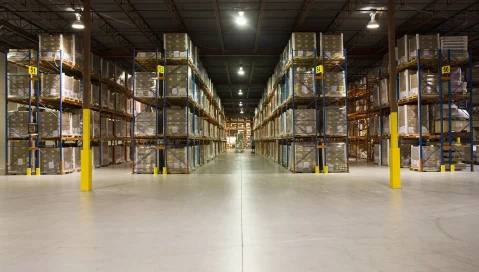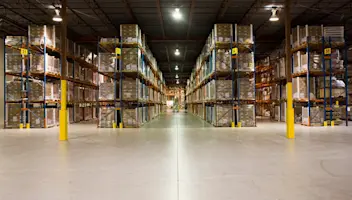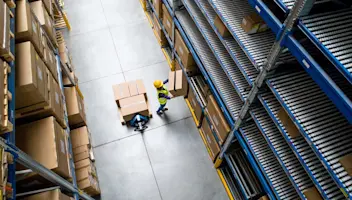Uitgelicht in deze blog
How Supply Chain Software Streamlines Every Stage of the Process
How Supply Chain Software Streamlines Every Stage of the Process
10 Jan 2023
Aptean Staff Writer
Whatever the size, goods or function of your logistics operation, you are part of something big—the global logistics industry. You play an essential role in your country’s economy by facilitating the import, export and movement of the nation’s goods.
The collective feat of logisticians is extraordinary and the scale of projects undertaken by operators is quite remarkable—especially when you consider the daily tasks of individual delivery operations and the collective performance of the global supply chain industry.
Additionally, the growth of ecommerce, the expectation of next-day delivery, the massive investment in the global market and increased competition have added to the complexity of delivery chains and transportation operations. As a result, most companies are investing heavily in supply chain software to keep up with the surge in demand, shorten delivery times and increase visibility for greater communication internally and with partners and customers.
However, with challenges and uncertainty surrounding global supply chains—you must be fully prepared to avoid any potential risk to your business operations. That requires you to carry out strategic analysis of your processes and implement supply chain software to maximize them—ensuring they’re optimized for continuous improvement at every stage of the supply chain.
Those critical areas of the supply chain are manufacturing, storage, loading and the transportation of goods to the end customer. Each of these components need to operate at the highest efficiency level with seamless integration between functions for the logistics industry to fire on all cylinders.
Wherever you fit into the supply chain, the following questions from each step within the process will help you find the right solution to creating a more successful supply chain.

1. Manufacturing Stage
Does Your Warehouse Have the Correct Inventory To Fulfill the Required Materials?
Before launching your supply order, modern warehouse management systems (WMS) allocate the required quantity of stock needed to complete the fulfillment. The system maximizes the output of all your components to generate the best quality and the correct quantity of your finished goods.
Is Your Stock Easily Visible at Any Given Time?
Integrated transportation and warehouse systems provide complete visibility of what materials are entering your warehouse, how many there are of each and where exactly they’re going to and coming from.
Advancements in tracking software mean misplaced and miscounted stock is a thing of the past. You now have more control over inventory processes and peace of mind every single day.
Can You Improve the Run Times of Your Manufacturing Processes?
An advanced WMS not only digitally allocates the materials required to finish your order; the system oversees the picking tasks of your operators who carry out the process too. As well as a mobile navigational dashboard, radio frequency (RF) and voice-enabled live data, the system provides you with real-time updates and accessibility to all of your quantifiable information.
Put simply, your WMS should do more than just manage. As a global supply chain, we are at the stage where software takes you from "strength to strength" rather than simply "overseeing" daily tasks.

2. Warehouse and Storage Stage
Could Your Warehouse Be More Efficient?
If knowledge is power, the capture of product-specific data for your stock is a powerful tool to have. Accessible information includes:
Sell-by dates
Manufacture dates
Serial numbers
Temperature readings
Coupled with resource allocation and pick performance monitoring, modern WMS functions ensure complete control of all your operations across multiple sites.
Automation eliminates the risk of human error while helping you meet internal key performance indicators (KPIs) and increase your return on investment (ROI). Having a robust software platform infrastructure in place takes care of your most advanced warehouse requirements and enables you to deliver projects on-time and in-full.
Do You Have Enough Space for Your Stock?
WMS technology uses innovative predictors to quantify stock levels and their replenishments. Having the right amount of necessary stock and storing goods based on picking requirements allows you to make full use of warehouse space to manage volume and other inventory challenges.
With 55% of transportation managers still organizing their fleet with paper and manual processes, there’s so much available space to be harnessed by automating tasks and clearing out the "old storage cupboard."
Are You Feeling Pressure From Competitors?
If so, we have a solution for you: digital transformation.
Supply chain software that integrates all the core features of WMS and transport management system (TMS) is helping to improve the operations of leading operations all over the world.
A "one size fits all" system that simply lists information could be holding you back in a big way. The way forward is to customize and integrate the technology you use as a competitive advantage.
Where Are Your Tools? Got Any Spare Pallets Handy?
A worker without their tools cannot work—simple fact.
Using the best supply chain management (SCM) solutions allows you to generate cohesion and seamlessness. But for this, you need the right people using the right warehouse management tools.
Misplaced equipment or a missing stack of pallets here or there doesn’t feel like much of a loss, not until you add up the total costs at the end of the year.
Real-time tracking and stock checking/perpetual inventory will make your life easier while saving costs you may not have considered to be necessary.

3. Transportation Stage
Have You Been Affected by Driver and Labor Shortages?
There are ways to cut down on your daily workload without compromising efficiency. Automating tasks also saves labor costs and lowers expenses by reducing paper use and removing human error from manual tasks.
For your fleet, a TMS that includes advanced route optimization software gets fewer vehicles delivering goods faster. Fewer, more efficient journeys demand fewer drivers, reducing your wage bill and improving ROI in the process.
The system chooses the fastest routes for optimal efficiency after configuring the perfect loading pattern for your journey. Innovative TMS software optimizes loading based on your products’ size and eventual location, resulting in fewer drivers delivering more goods with fewer empty driver miles.
If managing and tracking a large fleet of drivers and traveling goods is a headache, rest assured that TMS is the answer.
Could You Be Spending Less on Fuel Costs?
TMS is growing in popularity at such an accelerated rate because it serves the dual functions of simplifying your fleet management and making sure journeys are fully optimized.
Making each truck more efficient with a multi-fleet support operation means you don’t need as many drivers delivering goods. Those who do, have shorter journeys and fewer drivers, all of which can save you a small fortune in fuel costs.
Does the Billing Process Slow Your Operations?
Alongside your TMS, an electronic proof of delivery (ePOD) system will allow your drivers faster completion times. Faster deliveries lead to more deliveries made, which eventually leads to significant ROI.
An independent device with barcode scanning and signature capture efficiencies the perfect way to sign-off orders. The ePOD system automatically sends a confirmation to your TMS system and notifies your end customer of delivery completion.

The Final Mile - Your End Customer
Are Your Customer Satisfaction Levels Consistently High?
We know that customer loyalty leads to customer retention, and your service needs to be the fastest, most accurate and most efficient it can be for that to happen. The ability to solve complex planning and organizational challenges improves the speed and accuracy of your service, leading to improved customer satisfaction levels.
Dynamic routing and scheduling, automatic allocation of jobs to trips, cross-docking capabilities and automated loading functions offer more precision and efficiency to your transportation management operations in your last mile logistics planning. With next-day service becoming a prime offering, any performance gaps could negatively impact your satisfaction levels.
Are Your Customers Fully Updated on the Whereabouts of Their Products?
Customers want to know the status of their order and when it will be delivered. Tracking functionality on a web-enabled interface enables your transportation team to monitor the progress of orders, vehicles and separate deliveries with real-time status updates and live ETAs.
Sending updates to your customers of any potential journey disruptions not only improves customer service but also reduces the risk of penalties for late or early deliveries.
A supplier/customer order portal enables customers to view inventory and place orders. Suppliers can then enter product consignments into the network for delivery and collection, while all orders can be tracked throughout the entire delivery and billing process for complete visibility.
Powering Your Entire Operation With Supply Chain Software
Many companies employ separate systems to manage their warehouse and transportation operations; however, a total logistics solution provides a comprehensive system that integrates WMS and TMS.
Whether transporting by road, sea, rail or air, the handling facilities from which those goods are distributed require an overwhelming amount of planning. The scale of these operations requires a level of precision that only automated logistics software can provide.
Whatever journey they go through, the transportation of goods requires some mode of freight. The majority of holding facilities can have hundreds of vehicles coming in and out of a single warehouse over one day. If your warehouse is not entirely in sync with the freight team, your supply chain could break down.
Similarly, suppose your vehicle is not loaded within its allocated time slot due to warehouse inefficiency. In that case, the backlog of orders, vehicles and repercussions on customer expectations could harm your business.
But, having the right technology in place can eliminate this challenge and ensure your business thrives. Advanced supply chain software will ultimately make your business stronger.
Choosing the Right Technology Partner
WMS, TMS, terminal and yard management, ePOD, bonded storage and dashboard reporting solutions are all available as integrated or standalone software modules. Why? We believe in empowering your entire supply chain from one end to the other, and providing you with a solution that fits your exact business needs.
Understandably, some warehouses and holding facilities may not require a transportation management system and some transportation managers may only require fleet management. The flexibility of the more advanced supply chain software means they can be implemented as standalone modules, enabling you to customize the software based on your most advanced logistics needs.
To thrive in the logistics industry, your business needs robust supply chain software. For your logistics supply chain to be most efficient, all sectors—from manufacturing and warehousing to transportation and billing—all need to operate to perfection, and satisfy the C-suite checklist.
We encourage you to analyze the critical areas of your business's supply chain and explore the right software solutions for your operational needs and warehouse management challenges.
Ready to discover more? Get in touch with our team of supply chain software experts to find out how our advanced systems can transform your operation.
Related Content


Verander vandaag nog uw magazijn
Bent u klaar om uw distributieactiviteiten naar een hoger niveau te tillen? Dan helpen we u graag.






